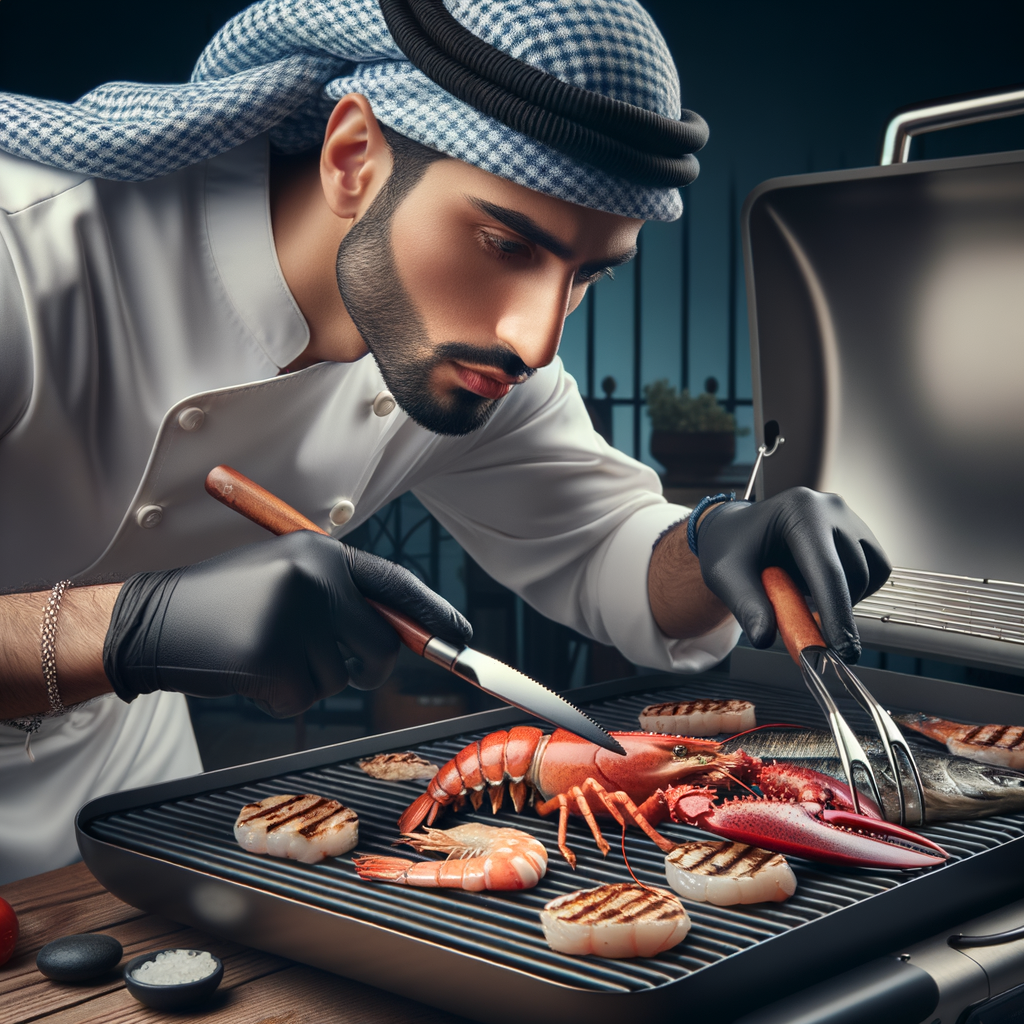
Introduction to Seafood Grilling
Grilling seafood might seem like a challenge, but with the right knowledge and techniques, it can be a delightful experience. Not only is it a healthy way to cook, but it also brings out the unique flavors of the sea. In this section, we will explore the importance and benefits of grilling seafood.
- The Importance of Grilling Seafood
- Benefits of Grilling Seafood
Grilling is one of the most popular methods of cooking seafood. It’s not just about the delicious taste, but also about the health benefits. Seafood is known for its high protein content and low fat. When you grill it, you don’t need to add extra oil or butter, making it even healthier.
Grilling seafood also helps retain its nutrients. For example, fish is rich in Omega-3 fatty acids, which are essential for heart health. When you grill fish, these beneficial nutrients are preserved.
There are several benefits to grilling seafood. First, it’s a quick and easy way to prepare a meal. Most seafood cooks in 10 minutes or less on the grill. This means you can have a healthy, delicious meal on the table in no time.
Second, grilling seafood enhances its flavor. The high heat from the grill sears the outside of the seafood, locking in the juices and creating a crispy, flavorful crust. This is a taste sensation that you just can’t get from other cooking methods.
Lastly, grilling is a fun and social way to cook. Whether you’re having a backyard barbecue with friends or a family dinner on the patio, grilling seafood is sure to be a hit.
Pro Chef Advice: Essential Seafood Grilling Tips
When it comes to grilling seafood, the advice of professional chefs can be invaluable. They have spent years mastering the art and science of grilling, and their tips can help you elevate your seafood grilling game to new heights. Let’s dive into their expert advice.
Choosing the Right Seafood for Grilling
One of the first steps in grilling seafood is choosing the right type of seafood. Not all seafood is created equal, and some types are better suited for grilling than others.
- Best types of seafood for grilling: According to professional chefs, the best types of seafood for grilling are those that are firm and hearty. These include fish like salmon, tuna, and swordfish. Shellfish such as shrimp, lobster, and scallops also grill well. These types of seafood can withstand the high heat of the grill without falling apart.
- How to select fresh seafood: Freshness is key when it comes to seafood. Look for seafood that has a fresh, clean smell. It should not have a strong fishy odor. The eyes of the fish should be clear and shiny, not cloudy or dull. The flesh should be firm, not soft or mushy. If you’re buying shellfish, the shells should be tightly closed. If they’re open, give them a tap. If they don’t close, they’re not fresh and should be avoided.
Remember, the quality of your seafood will greatly affect the end result of your grilling. So, take your time in choosing the best and freshest seafood you can find.
Preparing Seafood for Grilling
Before you can grill your seafood to perfection, there are two crucial steps you need to follow: cleaning and marinating, and proper cutting techniques. Let’s dive into these steps to ensure your seafood grilling is a success.
- Cleaning and Marinating Seafood
Firstly, it’s important to clean your seafood thoroughly. This involves removing scales, guts, and any other unwanted parts. For shellfish, make sure to scrub the shells clean. Once your seafood is clean, it’s time to marinate. Marinating not only adds flavor but also helps to keep your seafood moist during the grilling process.
Here’s a simple marinade recipe you can try:
| Ingredients | Amount |
|---|---|
| Olive oil | 1/2 cup |
| Lemon juice | 1/4 cup |
| Garlic, minced | 2 cloves |
| Salt | 1 teaspoon |
| Pepper | 1/2 teaspoon |
Combine all ingredients in a bowl, then soak your seafood in it for at least 30 minutes before grilling.
- Proper Cutting Techniques
Proper cutting techniques are essential when preparing seafood for grilling. The way you cut your seafood can affect how evenly it cooks. For fish, make sure to cut into even-sized fillets or steaks. For shellfish like shrimp or scallops, you can leave them whole.
Remember, the thickness of your seafood pieces will determine their grilling time. Thicker pieces will take longer to cook through. So, ensure all your pieces are of similar size for even cooking.
With these tips in mind, you’re now ready to grill your seafood to perfection. Happy grilling!
Grilling Techniques: Chef’s Grilling Secrets
Grilling seafood is an art, and like any art form, it requires a certain level of skill and knowledge. Here, we will delve into two key grilling techniques that chefs swear by: direct and indirect grilling, and understanding the importance of grill temperature.
- Direct vs Indirect Grilling
- Importance of Grill Temperature
Direct grilling involves placing the seafood directly over the heat source. This technique is best for thin and small pieces of seafood that cook quickly. It gives the seafood a nice sear, locking in the juices and flavor.
On the other hand, indirect grilling means the heat is on either side of the seafood, not directly under it. This method is perfect for larger, thicker pieces of seafood that need more time to cook thoroughly. It allows the seafood to cook evenly without burning the outside.
Understanding when to use each method can make a significant difference in the taste and texture of your grilled seafood.
Grill temperature plays a crucial role in grilling seafood. Too hot, and your seafood may burn on the outside before it’s cooked on the inside. Too cool, and your seafood may become dry and overcooked.
For most seafood, a medium-high heat (around 375 to 400 degrees Fahrenheit) is ideal. However, delicate seafood like fish fillets may require a lower temperature. Remember, it’s not just about the heat, but also about how long you cook your seafood. It’s a delicate balance that can take some practice to master.
In conclusion, mastering these grilling techniques can significantly improve your seafood grilling skills. Remember, practice makes perfect. So, don’t be afraid to experiment with different techniques and temperatures until you find what works best for you and your seafood.
Expert Seafood Grilling: Elevating Your Grilled Seafood
Grilling seafood is an art form that requires knowledge, skill, and a bit of creativity. But don’t worry, we’re here to help you elevate your grilled seafood game. Let’s dive into some pro tips that will take your seafood grilling to the next level.
Pro Tips for Grilling Seafood
Here are some expert tips that can help you grill seafood like a pro:
- Using wood planks for grilling: Grilling on wood planks is a great way to infuse your seafood with a smoky, woody flavor. Cedar, oak, and maple are popular choices. Soak the plank in water for at least an hour before placing it on the grill. This prevents it from catching fire and helps to create steam that cooks your seafood evenly.
- Grilling shellfish: dos and don’ts: Shellfish can be tricky to grill, but with a few tips, you can master it. Do preheat your grill to a medium-high heat. Don’t place shellfish directly on the grill grates, instead use a grill basket or foil. Do grill shellfish until their shells open, which indicates they’re done. Don’t eat any shellfish that didn’t open during grilling, as this could indicate they were dead before cooking and may not be safe to eat.
Remember, practice makes perfect. Don’t be afraid to experiment with different techniques and flavors. Happy grilling!
Chef Recommended Grilling Methods
When it comes to grilling seafood, professional chefs have a few tried-and-true methods that they swear by. Two of these methods are grilling with skewers and grilling with a grill basket. Let’s dive into each one.
- Grilling with skewers
Grilling with skewers is a popular method among chefs for its simplicity and versatility. Skewers allow for even cooking and easy flipping of seafood. They also add a fun and interactive element to the grilling process, making it a great choice for family barbecues or get-togethers.
Here’s a simple step-by-step guide to grilling with skewers:
- Choose your seafood. Shrimp, scallops, and chunks of firm fish like salmon work well.
- Pre-soak wooden skewers in water for at least 30 minutes to prevent them from burning.
- Thread your seafood onto the skewers. Don’t overcrowd them – leave some space between each piece to ensure even cooking.
- Preheat your grill to medium-high heat. Brush the grill grates with oil to prevent sticking.
- Place your skewers on the grill. Cook for 2-3 minutes on each side, or until the seafood is opaque and cooked through.
- Grilling with a grill basket
Grilling with a grill basket is another chef-approved method, especially for smaller pieces of seafood that could fall through the grill grates. A grill basket keeps your seafood contained while still allowing it to get that delicious grilled flavor.
Here’s how to grill with a grill basket:
- Choose your seafood. Small fish, shrimp, or diced pieces of larger fish are perfect for this method.
- Preheat your grill to medium-high heat. Place your grill basket on the grill to preheat as well.
- Toss your seafood in a little bit of oil and your favorite seasonings.
- Carefully place your seafood in the preheated grill basket. Close the lid of the grill.
- Cook for a few minutes on each side, or until the seafood is cooked through and lightly charred.
Whether you choose to grill with skewers or a grill basket, both methods will result in delicious, perfectly cooked seafood. Happy grilling!
Grilling Tips from Chefs: Case Studies
Let’s delve into some real-life examples of how professional chefs grill their seafood to perfection. We’ll start with a case study on grilling lobster tails.
Case Study 1: Grilling Lobster Tails
Grilling lobster tails may seem intimidating, but with the right preparation and grilling method, you can achieve a restaurant-quality result at home. Let’s look at how a professional chef does it.
- Preparation and grilling method:
- Key takeaways:
First, the lobster tails are cleaned and cut down the middle to expose the meat. The chef then marinates them in a mixture of melted butter, garlic, and herbs for about 15 minutes. The grill is preheated to medium heat, and the lobster tails are placed on the grill, shell side down. They are grilled for about 10 minutes, or until the meat is opaque and the shell is bright red. The chef bastes the lobster tails frequently with the marinade to keep them moist and flavorful.
There are a few important lessons we can learn from this case study. First, preparation is key. Cleaning and cutting the lobster tails properly can make a big difference in the final result. Second, marinating the lobster tails not only adds flavor but also helps to keep them moist during grilling. Finally, monitoring the grilling process closely and basting frequently can prevent the lobster tails from drying out.
By following these steps, you can grill lobster tails like a pro. In the next case study, we’ll look at another popular seafood item: scallops.
Case Study 2: Grilling Scallops
Scallops are a seafood delicacy that, when grilled correctly, can delight your taste buds. Let’s dive into the preparation and grilling method, followed by some key takeaways from our case study.
- Preparation and Grilling Method
Start by choosing fresh scallops. They should have a sweet, ocean-like aroma. Avoid those with a strong fishy smell. Once you have your scallops, rinse them under cold water and pat them dry.
Next, season your scallops. A simple seasoning of salt, pepper, and a drizzle of olive oil works wonders. Remember, the goal is to enhance the scallops’ natural flavor, not overpower it.
Preheat your grill to medium-high heat. Place the scallops on the grill and let them cook for about 2-3 minutes on each side. They should have a nice, golden crust on each side while still being tender on the inside.
Finally, serve your grilled scallops with a squeeze of fresh lemon juice for an added zing.
- Key Takeaways
Grilling scallops is a delicate process, but with a few key insights, you can master it:
- Always choose fresh scallops for the best flavor.
- Keep your seasoning simple to let the scallops’ natural flavor shine.
- Don’t overcook your scallops. They should be grilled just until they develop a golden crust.
- A squeeze of lemon juice at the end can elevate your grilled scallops to a whole new level.
With these tips in mind, you’re ready to grill scallops like a pro. Remember, practice makes perfect. So, don’t get discouraged if your first few attempts don’t turn out as expected. Keep trying, and soon, you’ll be grilling scallops to perfection.
Conclusion: Mastering Seafood Grilling
As we wrap up our journey into the world of seafood grilling, let’s take a moment to revisit the wisdom we’ve gathered from professional chefs and the tips we’ve learned to elevate our grilling game.
- Recap of professional chef advice
- Final tips for elevating your seafood grilling game
Our professional chefs shared their invaluable insights on seafood grilling. They emphasized the importance of selecting fresh seafood, maintaining the right grill temperature, and using the right grilling tools. They also highlighted the role of marination in enhancing the flavor of the seafood and the need to avoid overcooking to preserve the seafood’s texture and taste.
Now that we’ve learned from the best, it’s time to apply these lessons and elevate our seafood grilling game. Remember to experiment with different types of seafood and marinades. Don’t be afraid to try new grilling techniques. And most importantly, practice makes perfect. The more you grill, the better you’ll get at it.
Mastering seafood grilling is not just about following a set of rules. It’s about understanding the nuances of the process, adapting to different types of seafood, and constantly learning and improving. With the tips and advice we’ve discussed, you’re well on your way to becoming a seafood grilling master.
So, fire up your grill, get your favorite seafood, and start grilling. Happy grilling!






